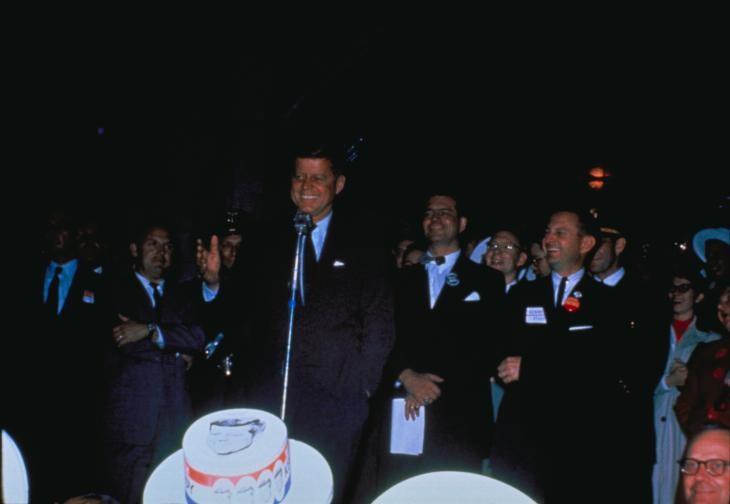Michigan Union
Introduction
Text-to-speech Audio
On October 14, 1960, John F. Kennedy stood on the steps at the Michigan Union, delivering a swift yet impactful speech at a campaign stop for the 1960 presidential election. While JFK flew in late intending to get some sleep, ten thousand students gathered at 1:40am, flooding State Street in anticipation of what their future president would say.
Images
JFK on the steps of the Michigan Union, 1960

Backstory and Context
Text-to-speech Audio
Student groups prepared questions, thousands paused to hear the improvised speech, and the university even raised the curfew for women—yes, you read that right, there was a curfew for women students back then. All normal campus life halted for this historic visit to hear JFK speak on the Peace Corps. JFK had not planned to speak at all but saw the students waiting in anticipation and knew he couldn’t ignore their signs and calls. As we will see, U-M students have a way of gaining the attention of authorities.
At this moment in his campaign, JFK introduced the Peace Corps, questioning students how they would serve others in their future careers. For context, the Peace Corps is a US governmental program that trains and deploys volunteers to provide development assistance abroad. Kennedy noted that U-M did not “... merely … help its graduates have an economic advantage in the life struggle,” implying that Michigan graduates do more with their newfound knowledge and careers. As Michigan students, we have a “greater purpose” to fulfill.
Weeks after the Ann Arbor visit, students greeted JFK with a petition signed by over one thousand students “... willing to serve abroad.” Carloads of students drove to meet JFK at the Toledo airport with this petition just two days before the election and many students did go on to donate their service as they promised years prior.
Although JFK was inspired by U-M students and their enthusiasm to help others—evident in the Peace Corps founding soon after his visit—this counters a common U-M narrative. The university and the students themselves did not directly cause the Peace Corps founding, as some say. In reality, U-M is a campus full of students dedicated to making a difference through activism, but major credit is unfortunately not due to the university. However, the student support for JFK’s progressive action calls and eagerness to serve demonstrates the timeless activism at our university. I’m sure that at the least, the student enthusiasm inspired JFK.
Since the Peace Corps founding about a year after the Union speech, nearly 2,700 U-M graduates have served in the program, working in over 60 countries in a variety of fields. Michigan is currently the number 4 university of total Peace Corps volunteers and ranks 4th on the Peace Corps’s Top Volunteer-Producing Colleges and Universities list. U-M now has a Peace Corps Office to “... help students prepare for … service,” continuing the legacy of JFK and the 1960 student body into the present.
Sources
Burns, Michael. “Kennedy Arrives for Campaign Foray.” Michigan Daily, October 14, 1960.
Buzynski, Isabella, Scott Flake, and Estrella Salgado. University of Michigan Presidential Campus Tour (online exhibit). Accessed October 20, 2022.
International Center, University of Michigan. “History of the Peace Corps at the University of Michigan. Accessed October 20, 2022.
International Center, University of Michigan. “Peace Corps at the University of Michigan.” Accessed October 20, 2022.
John F. Kennedy Library and Museum. “Peace Corps.” Accessed October 20, 2022.
Peace Corps. “The Founding Moment.” October 20, 2022.
Tobin, James. “JFK at the Union,” Michigan Today, January 3, 2008.
"JFK on steps of Union, 1960; BL005630". https://quod.lib.umich.edu/b/bhl/x-bl005630/bl005630. University of Michigan Library Digital Collections. Accessed November 15, 2022.
